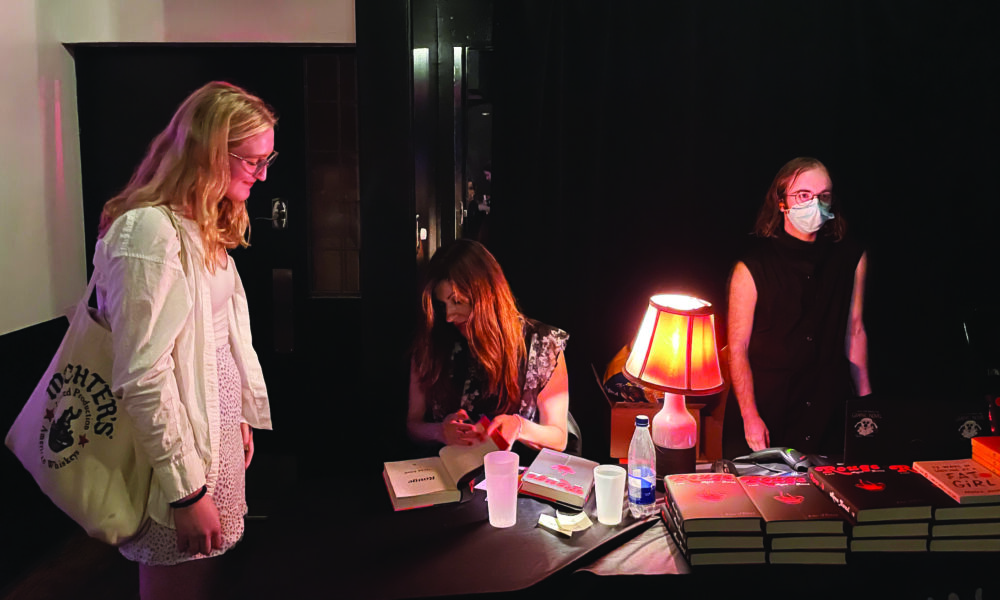Conversations buzzing, drinks flowing, and books in hand, eager readers livened the Mile End’s beloved bar and venue La Sotterranea on Wednesday, Sept. 12. Here to celebrate the launch of her new novel Rouge, Mona Awad stepped out onto the stage alongside interviewer Heather O’ Neill. Awad’s sparkling, Dorothy-esque red heels tapped away on the stage as she walked, and I knew from that instant that Awad’s creativity and ingenuity go far beyond her writing; her storytelling extends to the reality in which she lives.
Mona Awad, author of 13 Ways of Looking at a Fat Girl, All’s Well, and her most well-known piece of work, Bunny, has distinguished herself by her sharp, witty commentary in the midst of intricate and thrilling storylines. Her conversational partner for the night, O’ Neill (BA ‘94), is an award-winning Canadian author known for her short stories, essays, and her recent release, When We Lost Our Heads.
Bunny quickly rose to fame after its publication in 2019, receiving praise from Vogue, the ScotiaBank Giller Prize, and TIME magazine. Earlier this year, it was optioned by J.J. Abrams’ production company, Bad Robot. And production company Fremantle and Sinestra is currently optioning her newest book, Rouge, prior to the release of the novel.
As she introduced Awad, O’Neill described her writing as loud and full of risks. In Rouge, Awad uses the fairy tale structure as a stylistic device to explore desire and give voice to powerlessness. Drawing inspiration from Snow White, Awad explores themes of colourism, existentialism, and soul exploration in her clever and fascinating modernization. The book begins with the lead character Belle, a dressmaker, moving from Montreal to Los Angeles following her mother’s mysterious death. On a search to find answers, Belle finds herself entranced by a cult-like spa, promising unique solutions to achieve an eternal glow. The story analyzes a culture that is hypnotized by youthfulness and external beauty while keeping the readers invested in the characters’ fates.
When Awad began writing this piece, she immediately knew that it would be called Rouge. In fairytales, the colour red represents warning, Awad noted. She further stated that the colour red, or “Rouge”, informs the tone of the story. In the novel, she touches on Disney’s literalization of Snow White’s purity by associating it with her pale skin. In a culture that is built on eurocentric beauty standards, Awad writes on the struggle of young women of colour in seeing beauty when looking in the mirror. Dichotomous themes of enchantment versus envy, and hopefulness in contrast to powerlessness are embodied in this work.
The voice of reason within this bizarre yet fascinating modern twist of a tale is Awad’s commitment to honesty within each piece she writes. When asked about her relationship with the main character Belle, Awad notes that no piece of her work could be written without a part of herself attached to it. In this novel, the main character “Belle” shares Awad’s half-Egyptian heritage, suggesting an autobiographical reinterpretation of her own struggles in her gothic yet playful fairytale. In All’s Well, the main character suffers with chronic pain, something that the author has spoken about in her real life as well.
At the end of the night, I lined up to meet Awad and have her sign my copy of Rouge. Next to the signing, the artist No Joy played on stage, performing a psychedelic, shoegaze, dreamy mirage of a set. In a trance-like state after giving Mona Awad my pen when hers dried out and experiencing an extremely intimate conversation about beauty and colour, I walked out of the room feeling slightly more seen and slightly more hopeful. In a reality which is sometimes difficult to navigate, Mona Awad and her novel provide a brilliant and honest escape to a world that strangely mirrors our own.









